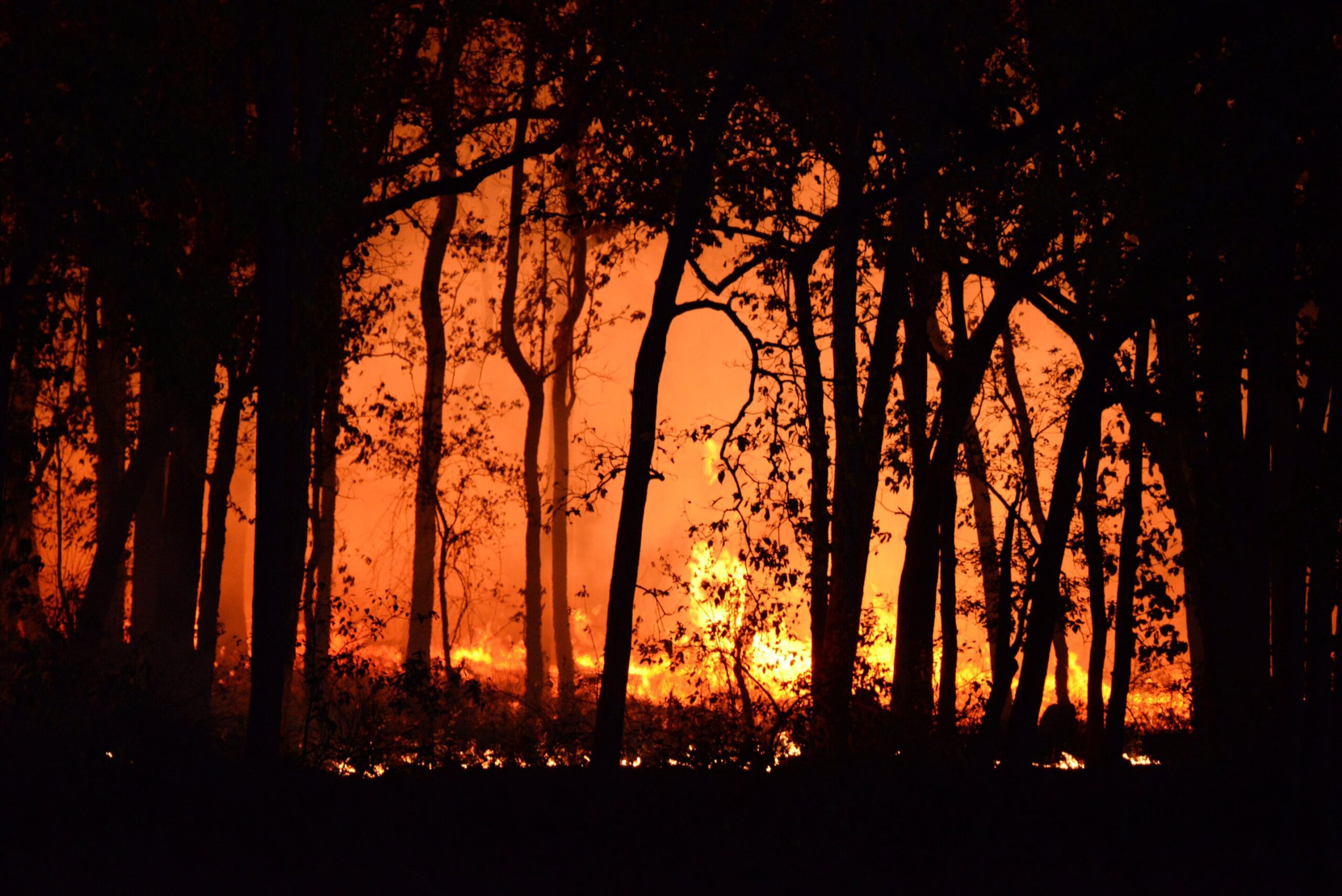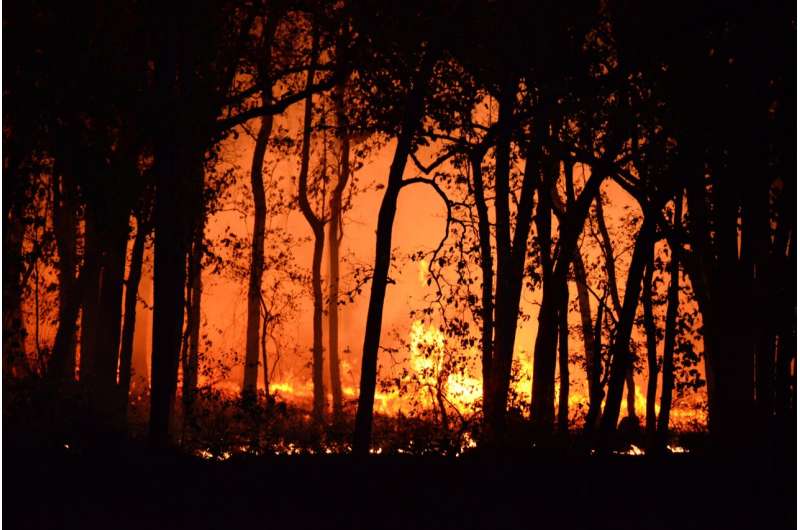

In a new study, North Carolina State University researchers have found that more extreme and frequent droughts would dramatically increase the amount of forest burned by wildfire in the southern Appalachian region of the Southeast through the end of the century.
In a study published in Fire Ecology, researchers found the most severe and frequent drought scenario would mean about 310 square miles of forest in the southern Appalachians burning every year in the decade ending in 2100. In comparison, there were around 231 square miles burned in 2016 in the mountain region—a year considered historic for wildfire in the southern Appalachians following multiple acts of arson, accidental ignitions and downed power lines.
“2016 was a watermark year for wildfire; we didn’t know we could have that much fire in the southern Appalachians,” said study co-author Robert Scheller, professor of forestry and environmental resources at NC State and associate dean for research in the NC State College of Natural Resources. “Under the most extreme conditions we forecasted, we would have the wildfire equivalent to that, or more, almost every year by the end of the century.”
In the study, researchers used computer modeling to project the total area burned by wildfire in the southern Appalachians of North Carolina, South Carolina, Georgia and Tennessee in 80 years across four scenarios that differed in terms of drought severity, and in terms of whether drought occurred in a year. They selected four of the most divergent outcomes in terms of drought intensity and timing that resulted from different climate warming models. All of the scenarios assumed high levels of greenhouse gas emissions that could cause between 2 and 7 degrees Celsius of climate warming on average by the end of the century, researchers said.
“All of our models fall under high emissions scenario, but there’s still a lot of uncertainty in how much warmer, and how much drier, the future is going to be, so we wanted to pick scenarios that were divergent,” said the study’s lead author Zachary Robbins, a former graduate student at NC State. “We also wanted to account for the fact that it’s anticipated that not only the amount of precipitation may change, but when precipitation occurs may dramatically change. Climate change is anticipated to give us very wet years and very dry years. Both of those are not ideal.”
Under the least extreme drought scenario, they projected a total of 231 square miles of forest would burn every decade through 2100—which is similar to the outcomes they predicted under historical climate conditions. In the most extreme scenario of high drought intensity and high variability of drought year to year, the total area of forest burned would double within the next decade, and increase by approximately 900%, or nine times, by the end of the century. That would mean around 3,125 square miles of forest burning in the decade ending in 2100.
Across the entire 80-year period of the study, they projected a nearly five-fold increase in total area burned under the more extreme scenario, for a total of more than 17,000 square miles. They also saw that more intense drought had a bigger impact on total area burned than variability in drought.
“This was the worst outcome from the most extreme drought scenarios, but that more extreme scenario could be on the low-end of the future reality,” Scheller said. “The existing climate models have underestimated the current drought and heat conditions that we’ve seen in California recently. We should expect that impacts of climate change will be seen in big-step changes—the impacts can happen really fast.”
They also saw that the same areas of forest would burn more frequently. Currently, a single point in the forest will not see a fire again for around 800 to 1,200 years on average, researchers said. But under their extreme drought conditions, they projected that fires would return to certain forest points every five years by the end of the century. And even though they predicted more frequent wildfire, their model only predicted a marginal increase in fire-adapted tree species—without direct efforts to restore them.
“It’s not going to shift back, even as all these fires are happening,” Scheller said.
Spatially, they found that wildfires were concentrated in national forests, outside of the urban interface where there are more cities and homes. More specifically, the northwestern and southwestern areas of their study area had the highest concentrations of wildfire, representing the boundaries of the Chattahoochee-Oconee and Cherokee National Forests.
“Most of the wildfire is going to occur in isolated acres where it’s difficult to suppress them, away from roads,” Robbins said.
However, they also reported that with increases in forest area burned, it is more likely that fire would reach urban areas.
“We may feel somewhat insulated from these big changes in fire that we’re seeing on the West Coast, and while we may not see the scale and intensity of those fires, we are moving in the direction of a lot more fire,” Scheller said. “It’s going to be a more common phenomenon and concern, and it’s going to affect forests, wildlife, water and where people build homes.”
In future work, the researchers are planning to explore how much prescribed burns or fire suppression tactics could impact wildfire patterns and growth of fire-adapted tree species. In addition, they also want to look at whether programs to prevent arson or accidental human wildfire ignitions could make a difference.
“We need to be prepared for more anomalous years,” Scheller said. “It’s all about clarifying resources. Do we have the equipment and the people power to potentially respond to more frequent major fire years?”
The researchers said their findings are meant to inform plans for development, firefighting resources and forest management.
“Our study shows that we’d be moving from fire years being anomalous among the Southern Appalachians, to there being a possibly of a major fire year, with greater than 195 square miles burned in wildfire, in your average year,” Robbins said. “The point isn’t to scare people, or to try to tell people exactly what the future is. The point is to use this information to develop management plans so we can make better choices around development, firefighting and restoration activities.”
More information:
Zachary J. Robbins et al, Fire regimes of the Southern Appalachians may radically shift under climate change, Fire Ecology (2024). DOI: 10.1186/s42408-023-00231-1
Provided by
North Carolina State University
Citation:
Climate change may make wildfires larger, more common in US southern Appalachian region (2024, January 16)
retrieved 16 January 2024
from https://phys.org/news/2024-01-climate-wildfires-larger-common-southern.html
This document is subject to copyright. Apart from any fair dealing for the purpose of private study or research, no
part may be reproduced without the written permission. The content is provided for information purposes only.

